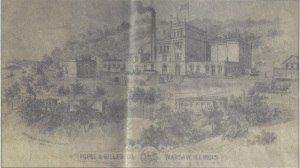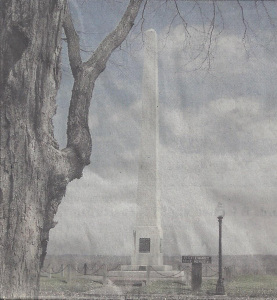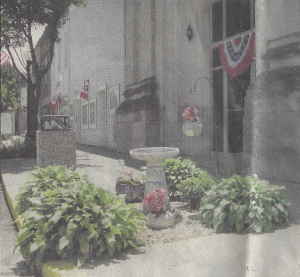Compiled by Cindy Iutzi and reprinted with permission from the Daily Gate City
The City of Warsaw, which sits on the east bank of the Mississippi River across from Alexandria, Mo., and south of the Mississippi’s confluence with the Des Moines River, got its start around 1812, an outgrowth of two forts and the settlement they fostered.

Popel & Giller Co. operated a brewing company for many years in Warsaw. Today, much of the site has undergone restoration and is now for sale.
According to Warsaw’s official history, Fort Johnson and Fort Edwards were built on the east side of the Mississippi River as counters to a British military installation about 100 miles north.
Fort Johnson was built between 1812 and 1814 on the city’s south bluff by then Maj. Zachary Taylor, who later became president of the United States. Taylor is believed to have demolished the fort in 1814.
Today’s Ralston Park was the area behind the fort’s stockade and near the fort’s parade ground.
In addition to soldiers posted in the area, by 1816, Native Americans from the Sauk and Iowa tribes settled near the fort and had started to raise corn.
Fort Edwards was built in 1817 on the northernmost bluff and named for Ninian Edwards, the first Illinois governor. The purpose of the log-constructed fort was to protect movement of supplies up the Mississippi River. Later it served as a fur trading post for mor than a d cade.
Today the forts are gone, but a monument honoring Fort Edwards was built in 1914 on the fort’s site and still stands.
Members of the Fox tribe were scattered along the Mississippi from Prairie du Chien, Wis., to Fort Edwards by 1822.
Early Warsaw residents Maj. John R. Wilcox, Mark Aldrich, John Montague and John Vineyard platted the city in 1834.

During the War of 1812, two forts were built on the Mississippi River bluffs where Warsaw is now located. From the Fort Edwards monument visitors can see three states, each with the same letter beginning and ending their names – AlexandriA, MO, WarsaW, IL and KeokuK, IA.
Wilcox had been stationed at Fort Edwards in 1822. He left for a short time after the fort was abandoned in 1824, then returned to live in the area.
He built a log cabin in 1827 near the Mississippi River just below the original site of Fort Johnson. His homeis believed to be “the first house in what was later to become the town of Warsaw,” according to the sesquicentennial history compilation.
Nine years later, Wilcox started a ferry that enabled the movement of people and commodities across the Mississippi from Warsaw to Alexandria and vice versa.
Aldrich arrived in Warsaw in 1832, building the second house in the town – a two-story log home.
Despite a brief time of upheaval during the Black Hawk War in 1832, Warsaw grew until there were about 24 inhabitants in 1834.
In the 1840s the Mississippi River opened up to passenger boats filled with “thousands … among them many emigrants, some from Ireland, oth- ers from Germany and France,” according to the sesquicentennial history.
Warsaw became a town in 1839 and a city in 1853.
Many people settled in Warsaw during that time, and commerce began to bloom: “… three distilleries, a tobacco factory, flour mills, brickyards, scores of cooperage shops. In 1845, the little town was claiming a population of 473; by 1850, 850,” according to the historical compilation.
“The French immigration began in the late 1850s and continued through the ’60s and ’70s. Many of the French people settled in Warsaw in the country extending from Warsaw to Basco,” according to the sesquicentennial history.
In 1855, a brick foundry was built on North Fourth Street where the brewery road turns east. Two’ years later, 20,000 bushels of grain were delivered to Warsaw for use by its three distilleries and three flour mills.
Thousands of barrels were made yearly for the shipment of lard, meat, apples, cider flour, whiskey and wine.
According to the sesquicentennial history, William Grover, Esq., of Warsaw in 1871 spoke to the Pioneer’s Association, describing Hancock County, Ill., on a trip he made from Carthage, Ill., to Warsaw in 1837:
“When the Black Hawk war broke out, the population of the county was still very small and thinly scattered and many settlers left the county for awhile. There were no actual depredations here by the Indians but there was, perhaps, just reason for apprehensions of danger. Fort Edwards was then standing upon that point, within 100 yards of this square. It had been abandoned some years before as a military post, but the buildings were then in possession of Col. Farnham, an agent ofthe government, and by his permission a number of men and a few families took shelter and protected themselves, if necessary. Among these were Co1. Farnham, Mark Aldrich and his wife, Isham Cochrane and his wife and James Wells. Among them was an Indian woman who was married to a white man and it is stated that she stood in more fear of an attack from Indians than any of the pale-faced women at the Fort.
“I have a distinct recollection of the appearance of the county from Carthage to Warsaw in 1837,” he said. “Coming west froin Carthage, the first house was then owned by William A. Patterson. The next was the Chapman place. The next places … were the farms of Benjamin Marsh and Gotham Clark, side by side. This brought us to the edge of what was then generally called The Warsaw Timber. From thence to Warsaw we passed Truman Hosford’s Bartholomew Slattery’s, the Vineyard farm (now part of Warsaw)and Mark Aldrich’s and from thence down a winding road through small timber and hazel brush to Andrew Monroe’s. At this point, we got upon Main Street, and passed a little frame building they used as a meeting house, and three other one-story frame houses of a single room each, on the south side of the street, one used by James Chittenden as a saddler shop, one by Samuel Brown and Wm. Mcllhenny, as a tailor shop, one by Smith Robbins, as a sort of fancy grocery.
On the other side of the street was a two-story frame house, unfinished, by R.L. Robertson. This brought us to the ‘Warsaw House’ then kept by mine host, ‘Old Man Newberry’ as the boarders irreverently called him; and here I slept my first night in a house after five months’ railroad exploration.
“I do not think there were then in all our large prairies a hundred improvements a mile distant from the timber. The few roads across the prairies followed the most favorable ground for settlement, regardless of section lines; and in some directions you might travel for hours without seeing a house or enclosure. If the direction of the beaten road did not suit you, you had full liberty of taking short and direct cuts to your journey’s end,” according to the historical compilation.
The first school board in Warsaw was elected in May 1855, and in June of the same year, it bought property on the summit of the hill owned by W. T. Turner. In 1857, a building was erected that was first called “The Seminary” and later “Warsaw High.” It was demolished in 1903.
The present high school was built in 1926. Warsaw schools became part of Community Unit School District No. 316, which also included Basco, Rockford, Sutter and Tioga.
In 2004, the high school was enlarged and renovated. This project had three different components – the addition of four more classrooms joining Warsaw Elementary School’s 1957 building and the 1977 addition; construction of an additional to Warsaw High School consisting of six classrooms, a new high school gym and commons/lunchroom area; and teh renovation and alterations to the existing 1929 building.
The cost of the project was $5 million. When completed the building would house students from kindergarten through 12th grade with a maximum capacity of 502.
Due to general declining enrollment in Hancock County, by 2009, Warsaw deactivated its junior high school and started bussing those students to Nauvoo, Ill. At the same time, the Nauvoo-Colusa district deactivated its high school and sent those students to Warsaw.
The first combined class of students who completed all four years at Warsaw High School graduated in the spring of 2012.
THE FLOODS
All of the years in which the Mississippi rose to unusual height are not available, but as far back as 1835, 1851 and 1853 water covered the whole valley from bluff to bluff, making a broad expanse of water from two to seven miles wide. From Warsaw to Lima Lake, “the whole of that rich and valuable bottom land was overflowed to a depth of several feet, while on the opposite side, it extended to the sand ridge five miles away, leaving Alexandria from four to eight feet under water. This was the same town that Mark Twain said came up every now and then to breathe,” according to history.
In 1880, Thomas Gregg said in his “History of Hancock County,” “But it will be observed that the ‘Father of Waters’ is by slow degrees gradually diminishing in volume. These high stages are becoming less frequent.”
“Little did he dream that over the next 80 years, so little progress would be made in tamping the old Mississippi, that in 1960 would come the flood that, although the damages created were small as compared with the good old days before the massive dam system slowed the major tributaries, was still so devastating and so spectacular as to attract nationwide interest via television and magazines,” according to the history.
Even so, the Flood of 1993 – described as a 500-year flood by the U.S. Army Corps of Engineers – surpassed all the recorded floods that had come before. The Mississippi River and all of its northern, central and south-central tributaries rose so high and flooded so much, they created something akin to a new Great Lake in the middle of Iowa that was visible via satelite for a while.
The Mississippi River rose to 27.58 feet at the Keokuk dam, closing the Keokuk-Hamilton Bridge and innundating the Warsaw Bottoms as well as low-lying properties in Warsaw and everything along its banks.
The approach to the Keokuk-Hamilton Bridge was underwater for days, as was the northern stretch of the Hamilton-Warsaw Road. Commuters crossed the dam by trolley and on foot from Hamilton in order to get to work in Iowa.
In 2008, the Mississippi River rose to the height of 26.98 feet and flooded much of the ground it had claimed in 1993.
GREAT RIVER ROAD
“‘The Great River Road,’ conceived by A.T. Greensfelder of St. Louis in the 1930’s, was to provide two roadway systems the entire length of the Mississippi River,” according Warsaw’s sesquicentenial history. “The road was planned as a backbone to which would be attached many existing and proposed parks, historical sites, lookouts and vistas, roadside parks and rest areas, public boat launching ramps, wild life preserves, fishing and hunting areas, thousands of lakes and recreational areas.”
The building of a proposed 4.8-mile segment of The Great River Road from Hamilton to Warsaw was announced in May of 1958, and preliminary surveying of the road was started.
Two months later, a meeting of Warsaw and Hamilton residents was held to determine the best routes for The Great River Road to enter Hamilton and Warsaw.
In September 1958, a citizens meeting was held in Warsaw to set committees for the aquisition of rights-of-way and to raise money.
By December 12, 1958, the “Gov. William G. Stratton Road” program included the Warsaw-Hamilton segment of The Great River Road.
On February 23, 1959, Fred and Mardelle DeYoung became the first, and Edwin and Elda Mae Beeler, the second, signers of deeds conveying rights-of-way for the project.
Thursday evening, May 21, 1959, porch lights were ‘lighted for Warsaw’ in a complete house-to-house canvass for funds with which to purchase the necessary land for The Great River Road,” according to historical material. “The sum of $16,000 was raised for the reimbursement of landowners on the right-of-way, and some land-owners donated their land.”
Dr. Alice Kibbe, botanist, donated a tract for the use of the road. The Alice Kibbe Field Station is accessed by the way Hamilton-Warsaw road.
On June 20, 1960, a contract for the building of 4.82 miles of the bituminous concrete surface between Warsaw and Hamilton was let for $1.3 million to S. J. Groves and Sons, Springfield, Ill. The amount did not include various bridges and culverts necessary for the road.
On July 20, 1960, an S. J. Groves and Sons Company bulldozer turned the first dirt and began the work. The regrading of slopes, seeding, landscaping and erection of guard rails were completed in the spring of 1962.
On June 16, 1962, traffic was stopped for the official opening of the Hamilton-Warsaw segment of the Great River Road. A ceremony was held honoring dignitaries and officials followed by a ribbon cutting ceremony.
The Warsaw portion of the Great River Road – two miles – officially reopened on Nov. 30, 2004, at the ribbon cutting celebration a $1.2 million rebuilding project that started in August 2004. Spearheaded by Mayor Robert Frank, the road was upgraded to withstand heavy grain truck traffic. The road was re-striped and new culverts and guarrails were installed.


Comments are closed.